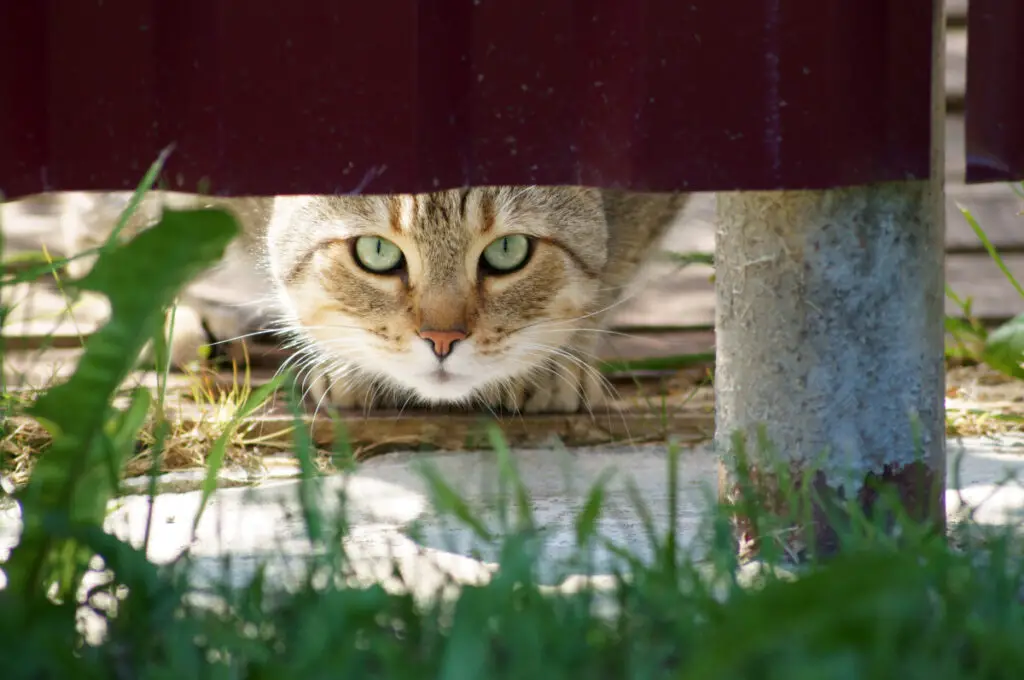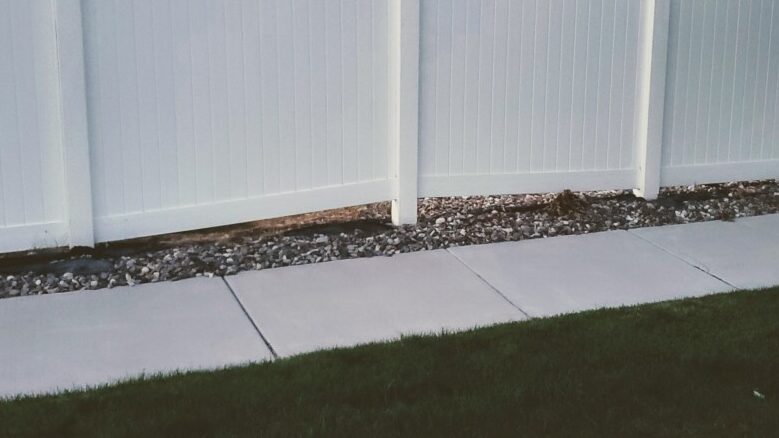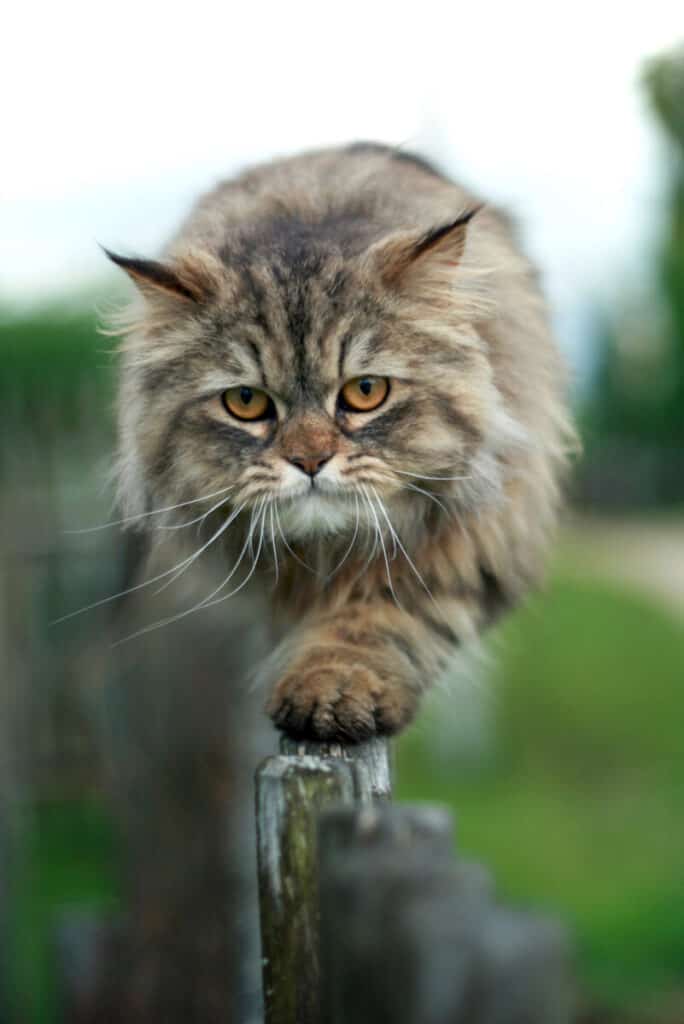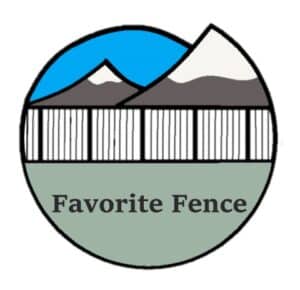Cat proofing the yard can be a challenge for many homeowners. With the ability to scale over and squeeze under almost anything, cats are one of the most difficult pets to detain.
Cat proofing the yard involves three steps: (1) making sure there are no bottom gaps below the fenceline that allow access to squeeze under, (2) ensuring the fence itself is unscalable, and (3) preventing any home or landscaping features from giving any alternative advantage to leaping and climbing over the top of the fence.
Keeping cats in or out of the backyard may be a priority for many people. Cats are agile and prolific climbers. They can vertically leap five or six times their height. Because cats love to hunt and to explore, anything that can provide just a couple of inches of leverage or access will provide an advantage for a cat to squeeze through, scale or climb.

Bottom Gap Filler
The first step in cat proofing the yard is to make sure that there are no locations that the cat can squeeze under. Most cats can potentially squeeze through any access, gap, or hole that is greater than two inches in diameter.

If any portion of the bottom of the fenceline exceeds two inches, it is necessary to fill in the gap or install a barrier to prevent in and out access. Consider the use of the following:
- Dig Defense
- Easy to install barrier that pounds into the ground (difficult to install in rocky soil)..
- Attracts little to no attention that provides an inconspicuous barrier for those areas along the fenceline that may otherwise provide in and out access to cats and other critters.
- Each spike is spaced 2 inches apart.
- Comes with a pack of 25 with each section being 8 inches tall and 32 inches long creating about 66.5 feet of total coverage.
- Provides a barrier for up to five inch gaps below the fenceline.
- Lawn & Landscape Border Edging
- Decorative treated natural wood lawn edging.
- Comes with a pack of 8, 4” x 30” sections (20 feet total).
- Sections can be linked and fastened together or installed individually where needed.
- Pound in Garden Landscape Edging
- Scalloped landscape edging made from recycled materials.
- Strong ground anchors that can be pounded deep into the ground to create a durable barrier.
- Comes with 16 sections that can be installed individually where needed or linked together creating up 18 feet of coverage.
- Galvanized Chicken Wire, 12 in by 150 ft
- Durable galvanized chicken wire can be staked into the ground (stakes not included) and trimmed with wire snippers for a custom fitted barrier.
- Durable twisted wire creates 1 inch hexagonal mesh openings measuring 12 inches wide and 150 feet long.
- Creates a barrier that prevents smaller cats and critters from passage.
Top Fence Barriers
Because of their sharp claws, cats can climb wood fences with ease. Chain link fences are more challenging. However, once a cat learns that their claws can create a hook and loop type grip on the fence, these too are easily scalable.

Vinyl Fences are Difficult for Cats to Climb
One of the most difficult types of fence for a cat to climb is vinyl. A vinyl fence is made with dense non porous polyvinyl material that cats cannot gain adhesion to with even the sharpest of claws. As long as there are no other home or landscaping features to use as a vantage point, a six foot vinyl privacy or semi-privacy fence may be adequate enough to prevent cats from over-the-top crossings.
However, if your fence is not vinyl, or if there are obstacles that a cat can use as a vantage point to gain access to the top of the fence, it may be necessary to install a top-fence barrier.
- Kitty Corral Fence Conversion System
- Ensures pet safety by preventing pets from mounting and crossing over the fence and into another property.
- Manufactured by EasyPetFence. Comes with a complete 100 foot containment system.
- Contains 12 Cat Fence Extender brackets that are bolted to the fence and designed to be spaced roughly 8 feet apart.
- Includes 4’ x 100’ heavy duty deer netting that can be trimmed if needed and is designed to be zip-tied to each bracket. It can also be fastened to the fence for additional reinforcement.
- Dog Proofer Fence Extension System
- Fence extension that adds up to 2 additional feet of height to any existing fence.
- Manufactured by Dog Proofer and provides a 100 foot barrier atop the fence (bracket screws not included).
- Designed to extend nearly 20 inches away from the fence to disallow larger cats and average dogs from using their hind quarters to leverage themselves up and over the fence.
- Comes with 12 galvanized and powder-coated extension arms that fasten to the fence and are designed to be spaced roughly 8 feet apart.
- A 4’ by 100’ polypropylene mesh is zip-tied to each extension arm and fastened to the fence.
- 36” Coyote Roller
- The Coyote Roller is a great way to prevent access to the top of the fence.
- Designed to be mounted at or near the top of the fence, any paws that attempt to take hold will roll off.
- Usually it is installed situationally—just where needed. However, it can also be installed in sequence around the fence perimeter (which can be very costly).
- Manufactured by Ultimation, the 36” roller is made with durable galvanized steel.
- The roller is spring loaded and easy to install between the brackets and also easily removed.
- Bracket mounting screws are not included.
Preventing other Means of Access to the Top of the Fence
Any landscaping feature that provides advantage or easy access to the top of a fenceline may need to be trimmed so that it is not in range of the top of a fence. Tree branches may need to be cut. Hedges may need to be scaled back.
Other home or landscaping features that cannot be moved, such as an airconditioning unit, may require additional measures to help deter cats from using it as a vantage point.
- Scat Mat
- Designed to help shape a cat’s behavior and territory patterns. Each mat is 13 X 16 inches and the set comes with a pack of 10 individual mats.
- The plastic mat has 1” long plastic prongs that do not hurt or injure the cat in any way. The spikes simply make the space uncomfortable and undesirable.
- Helps to prevent cats from digging, climbing, perching, crossing, or treading across specific areas.
- Manufactured by Homearden.
- Can be used anywhere—around trees, on rocks, in the garden, etc.
- Flexible and durable non-toxic material that can be trimmed to fit custom spaces.
- Air Blaster
- Battery operated motion detection activated with movement within three feet of the canister. Blasts a puff of air to startle a cat.
- Designed to help train cat behavior from perching or traveling across a specific space.
- Not intended for permanent outdoor use but can be temporarily placed on an AC unit or other features to help train cat behavior.
- Manufactured by PetSafe. Safe for all pets. Odorless.

